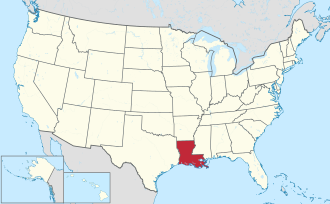2020 census
St. Martin Parish, Louisiana – Racial and ethnic composition
Note: the US Census treats Hispanic/Latino as an ethnic category. This table excludes Latinos from the racial categories and assigns them to a separate category. Hispanics/Latinos may be of any race.| Race / Ethnicity (NH = Non-Hispanic) | Pop 1980 [12] | Pop 1990 [13] | Pop 2000 [14] | Pop 2010 [15] | Pop 2020 [16] | % 1980 | % 1990 | % 2000 | % 2010 | % 2020 |
|---|
| White alone (NH) | 26,322 | 28,460 | 31,813 | 33,831 | 32,919 | 65.45% | 64.71% | 65.48% | 64.86% | 63.59% |
| Black or African American alone (NH) | 13,070 | 14,443 | 15,464 | 15,956 | 15,050 | 32.50% | 32.84% | 31.83% | 30.59% | 29.07% |
| Native American or Alaska Native alone (NH) | 26 | 78 | 136 | 214 | 177 | 0.06% | 0.18% | 0.28% | 0.41% | 0.34% |
| Asian alone (NH) | 131 | 310 | 440 | 393 | 440 | 0.33% | 0.70% | 0.91% | 0.75% | 0.85% |
| Native Hawaiian or Pacific Islander alone (NH) | x [17] | x [18] | 2 | 3 | 3 | x | x | 0.00% | 0.01% | 0.01% |
| Other race alone (NH) | 34 | 185 | 41 | 68 | 170 | 0.08% | 0.42% | 0.08% | 0.13% | 0.33% |
| Mixed race or Multiracial (NH) | x [19] | x [20] | 282 | 624 | 1,329 | x | x | 0.58% | 1.20% | 2.57% |
| Hispanic or Latino (any race) | 631 | 502 | 405 | 1,071 | 1,679 | 1.57% | 1.14% | 0.83% | 2.05% | 3.24% |
| Total | 40,214 | 43,978 | 48,583 | 52,160 | 51,767 | 100.00% | 100.00% | 100.00% | 100.00% | 100.00% |
At the 2000 United States census, [21] there were 48,583 people, 17,164 households, and 12,975 families residing in the parish. The population density was 66 inhabitants per square mile (25/km2). There were 20,245 housing units at an average density of 27 per square mile (10/km2). The 2019 American Community Survey determined 53,732 people lived in St. Martin Parish. [22] The median age of its population was 37.7, and 6.9% of its population were under 5 years of age; of the population aged 18 and older, they made up 75.7% of the population, and people aged 65 and older were 14.7% of the total population. By the 2020 United States census, there were 51,767 people, 19,749 households, and 13,960 families residing in the parish.
In 2000 the racial makeup of the parish was 65.95% White, 31.98% Black or African American, 0.92% Asian, 0.29% Native American, 0.20% from other races, and 0.65% from two or more races. Hispanics or Latino Americans of any race made up 0.83% of the population. The 2000 U.S. census counted 44,915 people in the parish who are at least five years old of whom 31,229 (69.5%) speak only English at home, 27.44% reported speaking French (Colonial French also known as Plantation Society French) or Cajun French at home, while 1.52% speak Louisiana Creole French. [23] St. Martin has the highest percentage of French-speaking residents of any county or parish in the United States.
In 2019, the racial and ethnic makeup of St. Martin was 66.8% non-Hispanic white, 29.1% Black and African American, 0.6% American Indian and Alaska Native, 1.0% Asian, 0.5% some other race, 2.1% multiracial, and 3.0% Hispanic and Latino American of any race. An estimated 1.0% of the parish were foreign-born from 2014 to 2019. At the 2020 census, non-Hispanic whites declined to 63.59% of the population; Black or African Americans were 29.07% of the population, and Hispanic and Latino Americans made up 3.24% of the population. [24]
In 2000 there were 17,164 households, out of which 39.70% had children under the age of 18 living with them, 54.60% were married couples living together, 15.90% had a female householder with no husband present, and 24.40% were non-families. 20.70% of all households were made up of individuals, and 7.90% had someone living alone who was 65 years of age or older. The average household size was 2.78 and the average family size was 3.22. The median income for a household in the parish was $30,701, and the median income for a family was $36,316. Males had a median income of $30,701 versus $18,365 for females. The per capita income for the parish was $13,619. About 18.40% of families and 21.50% of the population were below the poverty line, including 27.70% of those under age 18 and 22.10% of those age 65 or over. There were 19,749 households at the 2019 U.S. census estimates, and 4,800 businesses operating in the parish. [22] The parish had an employment rate of 53.8%, and its population lived in 23,384 housing units. There was a median gross rent of $658 and the median household income was $48,656. Approximately 18.9% of the parish lived at or below the poverty line, and males earned $51,609 versus $32,748 for females from 2015 to 2019.




